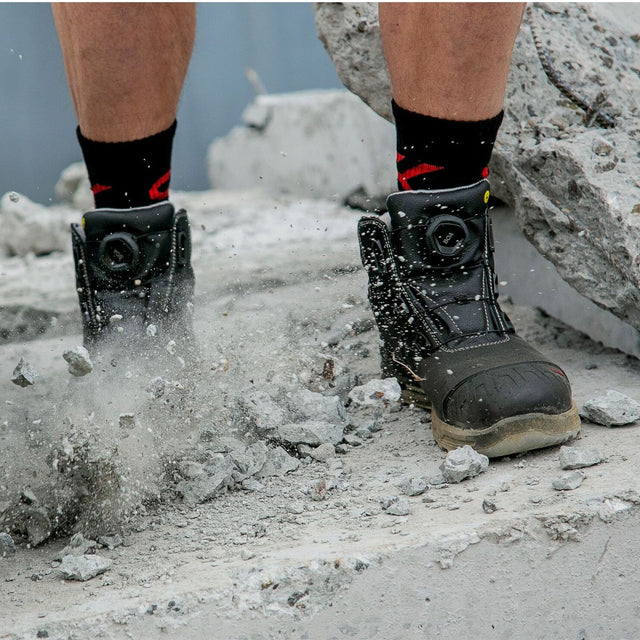What is the difference between a work boot and a safety boot?
Comparing apples with apples - safety footwear terminology explained.
While in some jurisdictions like in Australia a work boot can be identically referred to as a safety boot, in contrary, the distinction of the legal term in Europe as an example is quite clear on what is what.
In Europe as an example, a safety boot can only be referred to as a safety boot once the certification for the ISO safety standard is fulfilled. In Australia both terms can be legally used notwithstanding the boot's or shoes' compliance with the AS/NZS standard.
The work boots and safety boots are both types of footwear designed for various job-related purposes, but they serve different functions and provide distinct levels of protection.
Here are the main differences between the two:
-
General Purpose vs. Specialized Protection:
- Work Boots: Work boots are a broad category of footwear designed for general work environments. They offer basic protection and comfort for workers in industries such as construction, manufacturing, agriculture, and more. Work boots may have some safety features, but they are not specifically engineered for high-risk environments.
- Safety Boots: Safety boots, on the other hand, are specifically designed to provide protection in hazardous work environments. They come with various safety features, such as steel toe caps, metatarsal guards, puncture-resistant soles, electrical hazard protection, chemical resistance, and more. Safety boots are essential in industries with higher risks of injuries, such as construction, mining, oil and gas, and heavy machinery operations.
- Work Boots: Work boots are a broad category of footwear designed for general work environments. They offer basic protection and comfort for workers in industries such as construction, manufacturing, agriculture, and more. Work boots may have some safety features, but they are not specifically engineered for high-risk environments.
-
Protective Features:
- Work Boots: Work boots often focus on providing comfort, durability, and basic protection. They might have reinforced toe caps, slip-resistant outsoles, and water-resistant materials but may lack the comprehensive safety features found in safety boots.
- Safety Boots: Safety boots are equipped with specific safety features to safeguard workers from various potential hazards in their work environment. The most common safety feature is the steel toe cap, which protects toes from impact and compression. Additionally, safety boots may have metatarsal guards, puncture-resistant soles, electrical hazard protection, and chemical resistance to protect against specific workplace dangers.
- Work Boots: Work boots often focus on providing comfort, durability, and basic protection. They might have reinforced toe caps, slip-resistant outsoles, and water-resistant materials but may lack the comprehensive safety features found in safety boots.
-
Safety Standards and Certifications:
- Work Boots: Work boots may not necessarily adhere to specific safety standards, and their protective capabilities may vary based on the manufacturer and model.
- Safety Boots: Safety boots are manufactured in compliance with industry-specific safety standards and certifications. These standards ensure that the boots meet certain requirements for protection against specific workplace hazards. For example, safety boots might be certified to meet ISO or AS/NZS standards.
- Work Boots: Work boots may not necessarily adhere to specific safety standards, and their protective capabilities may vary based on the manufacturer and model.
Safety footwear (steel / composite toe cap boots and shoes) is the technical category name for ‘work boots’ or ‘steel caps’ as they are often referred to in Australia and New Zealand.
In the Australian and European standards (EN ISO 20345:2011 and AS2210.3 2019 respectively) safety footwear is required to contain a toe cap (steel, composite) that provides protection against an impact of 200 joules and a compression of 15 kN.
This is approximately a weight of 20 kilograms falling from a height of 1 meter and a compression weight of 1.5 t.
The safety toe cap does not have to be made of steel (Can also be made of plastic, composite material, aluminium, etc) as long as it meets the relevant criteria in the safety standard.
The safety footwear standards also cover other aspects of protection against mechanical impact, slips risks, environmental conditions, some hazardous environments and the overall design, construction and performance of the footwear.
ELTEN work boots and safety shoe is certified with the European Standard (EN ISO 20345) and complies with the Australian Standard (AS 2210.3).
These standards have been developed to provide a minimum standardised level of protection to workers in hazardous working environments. Also note there can be several additional requirements such as chain saw protection as well as fire protective boots which vary in their safety standards.
In summary, work boots provide general protection and comfort for various work environments, while safety boots are specialized footwear designed to offer maximum protection in hazardous workplaces where there is a higher risk of injury.
When choosing between the two, it's essential to consider the specific safety requirements of your job and select the appropriate type of footwear accordingly as well as considering the jurisdiction for each country with regards to safety standards.
If you have any further questions, please contact our customer service team in Tullamarine on 03 6161 3933 or at hello@stitchkraft.co

